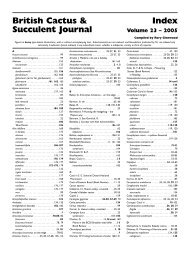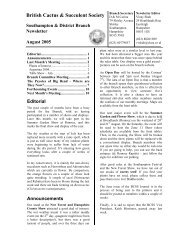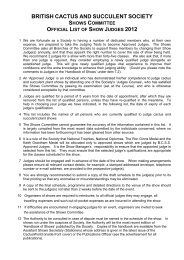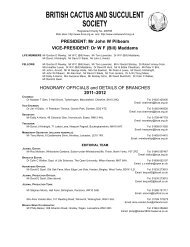British Cactus & Succulent Society - southampton.bcss.org.uk
British Cactus & Succulent Society - southampton.bcss.org.uk
British Cactus & Succulent Society - southampton.bcss.org.uk
You also want an ePaper? Increase the reach of your titles
YUMPU automatically turns print PDFs into web optimized ePapers that Google loves.
BCSS Southampton & District Branch – May 2005 Newsletter Page 2Thanks are due to David Corina for providing thefollowing write-up of last month’s talk by StirlingBaker.Interesting HaworthiasThis was a two-part programme featuring plantsin the first half and slides in the second. Stirlingopened his talk by quoting a definition of(Haworthia) species by Bruce Beyer [fromHaworthiad, the journal of the Haworthia society]which he, and most of the audience, foundincomprehensible! Bayer is probably the currentauthority on the genus, and his system ofnomenclature is generally accepted.There is considerable variation in Haworthias,plants of the same nominal species vary widelyover their range and this has led to a proliferationof names. [See postscript 1] Stirling had broughtalong ‘typical’ examples of plants that were‘accepted for the name’ as he put it. Not allHaworthia species were covered, only those thathe thought were worth growing. The plants werediscussed in ‘groups’ based on growth formsrather than the botanical divisions. As most ofthis text is discussing one genus, I shall imitateStirling and omit the ‘H.’ and just give the speciesnames in the account below.Probably most people in the audience had hopedfor lots of tips on how to grow Haworthias, butStirling did not spend much time on this topic.His basic tips were to grow in bright light (to getgood colours) but not full sun all day, and give asmuch air as possible – alpine house treatment!Most Haworthias tend to grow early in the year.Best to repot into one’s own compost, in a deeperpot where possible. This enables you to check theroots and remove any dead ones. Current wisdomstates that Haworthias ‘re-root’ every year. Therehas been much written about composts forHaworthias, and in the past a heavy soil-basedmix was advocated, but current ideas favour alighter mixture containing (expanded) pumice fordrainage, and even growing in the completelyartificial medium Seramis [see BCSS Journal19(3) 2001 p.158]. Suggested mode ofpropagation from seed was to sow about 10 seedson the top of seed compost in a 2" square pot,cover with a sprinkle of silver sand, water fromthe bottom with hot water and enclose the pot in apolythene bag. Keep the seedlings growing on inthe shade.Cuttings are not theoretically possible for thestemless species but it is possible to cut thecentres out of the plants and hope that newrosettes are formed from the stump. Plants cannotbe grafted. Many species will propagate fromleaves, and the stemmed species can have the topsre-rooted (hormone rooting powder and bottomheat recommended). Otherwise plants can besplit up into the offsets and started again – often agood idea for old plants.If you are a real enthusiast (or a masochist!), thenread on … …otherwise go to end!First plants out of the box were the group withsomewhat incurving, soft tufted leaves edged with‘bristles’, typified by arachnoidea, a variable,slow species; a good form of this is scabrispina.Although the leaves are soft, this group of plantscan withstand drought (by closing up the rosette)and strong light (the bristles filter the sun). Allare slow growers, usually solitary for theirlifespans with us! Other familiar species in thegroup are bolusii and its var. aranea, and var.palmiana(?) which looks like arachnoidea; thennortieri, difficult, keep cooler and out of the sun;and semiviva, an autumn grower. Next camemucronata and its var. morrisiae and the similarhabdomadis var. inconfluens. Lastly, the reallychoice species: lockwoodii needs no introductionbut Stirling reserved the term ‘gems’ for the smallsoft leaved species pulchella (the original form,very slow, 15 to 20 year old plant still in a 23/4in. pot), pubesens, archeri (now in withmarumiana) and archeri var. dimorpha.Although larger and easier to grow, cooperi andform venusta were included in this group. Withall of the above, there are many clones around andit is best to choose a good one. A general hint oncultivation was that if the rosette is tightly closed,give a drink, if open, do not!Probably the most popular group are the flatleavedretusae types, typically the emelyae-pictacomplex. There are lots of forms and varieties,e.g. emelyae var. major. Need to buy these “onsight” to get good forms. A clumping species ispygmaea and pygmaea var. argentea maculosa(but some are wrongly named, ‘splendens’ nowregarded as magnifica splendens); choose goodleaf markings. H. comptoniana is now regarded asa variety of emelyae and can grow quite large; itappreciates some shade. For mirabilis, the var.badia is the best, and var. buekmannii clumpswell but then falls to bits, so start again!Bayeri/uniondalensis is liable to burn if kept toosunny. Other popular species in this group aremaughnii (which can get quite big) and truncata,which really need no introduction, but others are
















